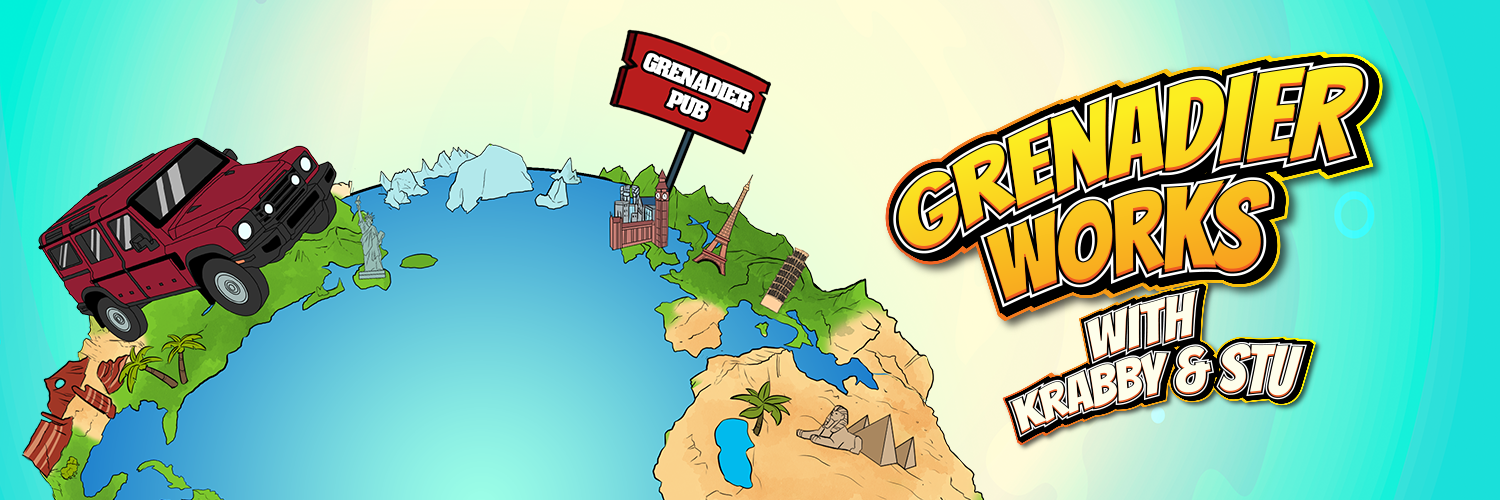Wow, many thanks for this. Mine has been off from new, been back to the dealer but they haven’t been able to sort it out so definitely going to give this a go.Hi Parb, Here's the fix for an off centered steering wheel. DaBull
I decided to tackle the 2-degree steering wheel offset from top dead center that my Grenadier had. I hate to admit it that is was driving me a bit batty. Although I knew having the steering wheel moved to top dead center would not change anything except my perception, I am loving the new perception.
These instructions are for the US Left Hand Drive Vehicles. Not sure if they would be exactly the same for Right Hand Drive Vehicles.
TOOLS
WD-40 to first spray on the captive nuts and threads to make it easier to release the captive nuts.
2 large adjustable wrenches. I purchased mine from Harbor Freight.
3M blue tape and permanent marker to set up a reference scale, see photo.
Something to lie on while wrenching away.
Tef Gel or anti-seize to put on threads to make it easier to undo the captive nuts the next time.
Some Red Paint to mark the final adjustment.
A bit of strength to wrench loose the captive nuts, it helps if you know which way to turn them first, which I did not.
Here’s a couple photos on how to go about adjusting the steering wheel to be top dead center. Note: This does not change the alignment of the suspension.
One photo has instructions and the other shows a strip of blue 3M tape I marked up and wrapped around the large wide center nut so I could visually see and make note of what adjustments I was making. The numbers are just for reference and could have easily been A,B,C instead.
Once you have the 2 captive nuts loose, you can then turn the large wide center nut. Simply make 1/6th turn adjustments at first and then take it for a short drive, (Yes, I know you should tighten up the 2 captive nuts first, however I choose not too during the test drive). Keep in mind when taking a test-drive that most roads have a slope/slant that falls off to the side to facilitate drainage during rains. As such, you will find the steering wheel will be 1-2 degrees off for the vehicle to compensate for the sloped road. The trick is to find a level road and then drive it in both directions to judge how well your adjustment is working on level roads and then make further fine adjustments from there. I took my wrenches along for the test-drives and pulled over and made adjustments as needed until I was happy. Once back home, I spread some anti-seize, (I used Tef-Gel), on the threads to make it easier to wrench them loose in the future and then tightened up the captive nuts as hard as I could. I also purchased a small paintbrush and some red paint to make a straight line across the all the nuts so that I could easily peak underneath from time to time to make sure nothing was coming loose. It’s very important to tighten those captive nuts and keep an eye on them to make sure they are not coming loose!
Now that I have finished this project, Everything In The Universe is Now Perfectly Aligned. DaBull
View attachment 7865432View attachment 7865433View attachment 7865434View attachment 7865435View attachment 7865436
My
The Grenadier Forum
Register a free account today to become a member! Once signed in, you'll be able to contribute to the community by adding your own topics, posts, and connect with other members through your own private inbox! INEOS Agents, Dealers or Commercial vendors please use the contact us link at the bottom of the page.
You are using an out of date browser. It may not display this or other websites correctly.
You should upgrade or use an alternative browser.
You should upgrade or use an alternative browser.
Centered steering wheel when going straight?
- Thread starter parb
- Start date
mine is perfect. you'll really like it when the alignment is mint and the steering is centered! i also have a replaced my steering dampener and i really like my steering now.
I have tried to break the locking nuts free and can’t get them to budge. I’ve used WD but they are stuck. Was it difficult for you? Did you lift the vehicle?Hi Parb, Here's the fix for an off centered steering wheel. DaBull
I decided to tackle the 2-degree steering wheel offset from top dead center that my Grenadier had. I hate to admit it that is was driving me a bit batty. Although I knew having the steering wheel moved to top dead center would not change anything except my perception, I am loving the new perception.
These instructions are for the US Left Hand Drive Vehicles. Not sure if they would be exactly the same for Right Hand Drive Vehicles.
TOOLS
WD-40 to first spray on the captive nuts and threads to make it easier to release the captive nuts.
2 large adjustable wrenches. I purchased mine from Harbor Freight.
3M blue tape and permanent marker to set up a reference scale, see photo.
Something to lie on while wrenching away.
Tef Gel or anti-seize to put on threads to make it easier to undo the captive nuts the next time.
Some Red Paint to mark the final adjustment.
A bit of strength to wrench loose the captive nuts, it helps if you know which way to turn them first, which I did not.
Here’s a couple photos on how to go about adjusting the steering wheel to be top dead center. Note: This does not change the alignment of the suspension.
One photo has instructions and the other shows a strip of blue 3M tape I marked up and wrapped around the large wide center nut so I could visually see and make note of what adjustments I was making. The numbers are just for reference and could have easily been A,B,C instead.
Once you have the 2 captive nuts loose, you can then turn the large wide center nut. Simply make 1/6th turn adjustments at first and then take it for a short drive, (Yes, I know you should tighten up the 2 captive nuts first, however I choose not too during the test drive). Keep in mind when taking a test-drive that most roads have a slope/slant that falls off to the side to facilitate drainage during rains. As such, you will find the steering wheel will be 1-2 degrees off for the vehicle to compensate for the sloped road. The trick is to find a level road and then drive it in both directions to judge how well your adjustment is working on level roads and then make further fine adjustments from there. I took my wrenches along for the test-drives and pulled over and made adjustments as needed until I was happy. Once back home, I spread some anti-seize, (I used Tef-Gel), on the threads to make it easier to wrench them loose in the future and then tightened up the captive nuts as hard as I could. I also purchased a small paintbrush and some red paint to make a straight line across the all the nuts so that I could easily peak underneath from time to time to make sure nothing was coming loose. It’s very important to tighten those captive nuts and keep an eye on them to make sure they are not coming loose!
Now that I have finished this project, Everything In The Universe is Now Perfectly Aligned. DaBull
View attachment 7865432View attachment 7865433View attachment 7865434View attachment 7865435View attachment 7865436
My
DaBull hasn't been seen on here since the end of February 2025.I have tried to break the locking nuts free and can’t get them to budge. I’ve used WD but they are stuck. Was it difficult for you? Did you lift the vehicle?
The centre barrel jam nuts are torqued to 250Nm (~185 ft.lbs) so expect them to be tight. Also do pay attention to the left hand thread which is the larger nut.
For the jam nuts you need a 36mm and 40mm open spanner or crowfoot wrench. Adjustable wrenches will work in an pinch. Not recommended due to the high torque loading.
A crowfoot wrench in 1/2 square drive would allow you to use an extension handle. 3/8 drive if that's all you have. 3/4 drive is overkill.
From memory the barrel nut flats are also 36mm but you only need to hold that to make fine adjustments and to stop it from moving while retorquing the jam nuts so a large adjustable wrench will do there.
It can be done on the ground laying on your back but would be easier done overhead on a hoist.
Similar threads
- Replies
- 3
- Views
- 284
- Replies
- 6
- Views
- 743
- Replies
- 13
- Views
- 542



